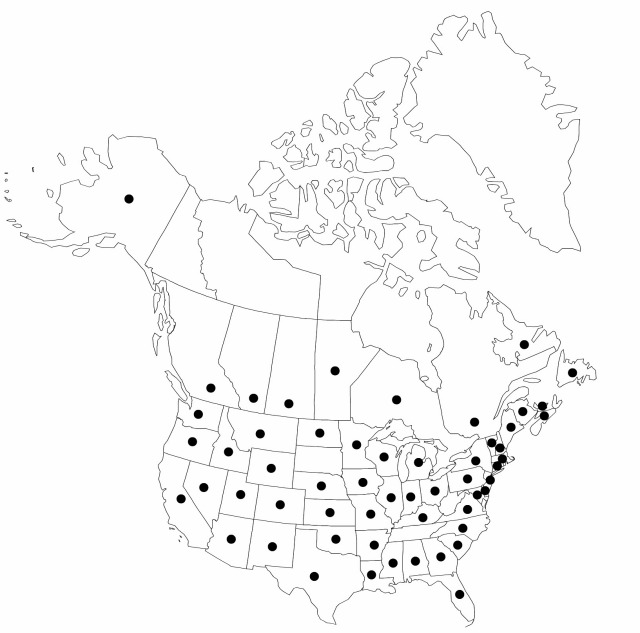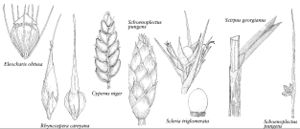Difference between revisions of "Schoenoplectus pungens"
Verh. K. K. Zool.-Bot. Ges. Wien 38(Sitzungsber.): 49. 1888.
FNA>Volume Importer |
imported>Volume Importer |
||
| (3 intermediate revisions by 2 users not shown) | |||
| Line 8: | Line 8: | ||
}} | }} | ||
|common_names=Common three-square bulrush;chair-maker’s rush;scirpe acere | |common_names=Common three-square bulrush;chair-maker’s rush;scirpe acere | ||
| + | |special_status={{Treatment/ID/Special_status | ||
| + | |code=F | ||
| + | |label=Illustrated | ||
| + | }} | ||
|basionyms={{Treatment/ID/Basionym | |basionyms={{Treatment/ID/Basionym | ||
|name=Scirpus pungens | |name=Scirpus pungens | ||
|authority=Vahl | |authority=Vahl | ||
| + | |rank=species | ||
|publication_title=Enum. Pl. | |publication_title=Enum. Pl. | ||
|publication_place=2: 255. 1805 | |publication_place=2: 255. 1805 | ||
| Line 30: | Line 35: | ||
|distribution=Alta.;B.C.;Man.;N.B.;Nfld. and Labr.;N.S.;Ont.;P.E.I.;Que.;Sask.;Ala.;Alaska;Ariz.;Ark.;Calif.;Colo.;Conn.;Del.;Fla.;Ga.;Idaho;Ill.;Ind.;Iowa;Kans.;Ky.;La.;Maine;Md.;Mass.;Mich.;Minn.;Miss.;Mo.;Mont.;Nebr.;Nev.;N.H.;N.J.;N.Mex.;N.Y.;N.C.;N.Dak.;Ohio;Okla.;Oreg.;Pa.;S.C.;Tex.;Utah;Vt.;Va.;Wash.;Wis.;Wyo.;Mexico;West Indies;South America;Europe;Australia (including Tasmania);New Zealand. | |distribution=Alta.;B.C.;Man.;N.B.;Nfld. and Labr.;N.S.;Ont.;P.E.I.;Que.;Sask.;Ala.;Alaska;Ariz.;Ark.;Calif.;Colo.;Conn.;Del.;Fla.;Ga.;Idaho;Ill.;Ind.;Iowa;Kans.;Ky.;La.;Maine;Md.;Mass.;Mich.;Minn.;Miss.;Mo.;Mont.;Nebr.;Nev.;N.H.;N.J.;N.Mex.;N.Y.;N.C.;N.Dak.;Ohio;Okla.;Oreg.;Pa.;S.C.;Tex.;Utah;Vt.;Va.;Wash.;Wis.;Wyo.;Mexico;West Indies;South America;Europe;Australia (including Tasmania);New Zealand. | ||
|discussion=<p>Three varieties of <i>Schoenoplectus pungens</i> (under <i>Scirpus</i> americanus) were recognized for North America by T. Koyama (1963), and three more or less equivalent varieties were recognized by S. G. Smith (1995). These varieties are described informally and illustrated here but not formally recognized because their morphologic delimitation should be evaluated and their exact ranges are still uncertain.</p><!-- | |discussion=<p>Three varieties of <i>Schoenoplectus pungens</i> (under <i>Scirpus</i> americanus) were recognized for North America by T. Koyama (1963), and three more or less equivalent varieties were recognized by S. G. Smith (1995). These varieties are described informally and illustrated here but not formally recognized because their morphologic delimitation should be evaluated and their exact ranges are still uncertain.</p><!-- | ||
| − | --><p><i>Schoenoplectus pungens</i> (Vahl) Palla < | + | --><p><i>Schoenoplectus pungens</i> (Vahl) Palla <i></i>var.<i> pungens</i> has brown to straw-colored spikelet scales, bifid styles, and lenticular achenes. It is the only variety that occurs in Europe and North America. In North America, it extends from the Atlantic Coast to Saskatoon and is reported from Arkansas, Kansas, Louisiana, Minnesota, and Missouri.</p><!-- |
--><p><i>Schoenoplectus pungens</i> (Vahl) Palla var. longispicatus (Britton) S. G. Smith has bright orange to reddish (or purplish) brown or often stramineus and lineolate-spotted spikelet scales, trifid styles, and trigonous to lenticular achenes. Endemic to the flora area, variety longispicatus occurs in western North America, except Pacific Coast, east to Saskatoon, Manitoba, and Ontario, along the north shore of Lake Superior, south to Iowa, Minnesota, western Wisconsin, Missouri, and southern Mississippi.</p><!-- | --><p><i>Schoenoplectus pungens</i> (Vahl) Palla var. longispicatus (Britton) S. G. Smith has bright orange to reddish (or purplish) brown or often stramineus and lineolate-spotted spikelet scales, trifid styles, and trigonous to lenticular achenes. Endemic to the flora area, variety longispicatus occurs in western North America, except Pacific Coast, east to Saskatoon, Manitoba, and Ontario, along the north shore of Lake Superior, south to Iowa, Minnesota, western Wisconsin, Missouri, and southern Mississippi.</p><!-- | ||
--><p><i>Schoenoplectus pungens</i> (Vahl) Palla var. badius (J. Presl & C. Presl) S. G. Smith has uniformly dark chestnut spikelet scales, trifid styles 3-fid, and trigonous or thickly biconvex achenes. In North America, variety badius occurs along the Pacific Coast (to slightly inland) from British Columbia south to California. Outside the flora area it occurs in Baja California, Mexico, temperate South America, Australia, including Tasmania, and New Zealand.</p><!-- | --><p><i>Schoenoplectus pungens</i> (Vahl) Palla var. badius (J. Presl & C. Presl) S. G. Smith has uniformly dark chestnut spikelet scales, trifid styles 3-fid, and trigonous or thickly biconvex achenes. In North America, variety badius occurs along the Pacific Coast (to slightly inland) from British Columbia south to California. Outside the flora area it occurs in Baja California, Mexico, temperate South America, Australia, including Tasmania, and New Zealand.</p><!-- | ||
| Line 43: | Line 48: | ||
-->{{#Taxon: | -->{{#Taxon: | ||
name=Schoenoplectus pungens | name=Schoenoplectus pungens | ||
| − | |||
|authority=(Vahl) Palla | |authority=(Vahl) Palla | ||
|rank=species | |rank=species | ||
| Line 57: | Line 61: | ||
|publication title=Verh. K. K. Zool.-Bot. Ges. Wien | |publication title=Verh. K. K. Zool.-Bot. Ges. Wien | ||
|publication year=1888 | |publication year=1888 | ||
| − | |special status= | + | |special status=Illustrated |
| − | |source xml=https:// | + | |source xml=https://bitbucket.org/aafc-mbb/fna-data-curation/src/2e0870ddd59836b60bcf96646a41e87ea5a5943a/coarse_grained_fna_xml/V23/V23_71.xml |
|genus=Schoenoplectus | |genus=Schoenoplectus | ||
|section=Schoenoplectus sect. Schoenoplectus | |section=Schoenoplectus sect. Schoenoplectus | ||
Latest revision as of 20:42, 5 November 2020
Rhizomes often vertical, 1–6 mm diam., firm to hard; scales shorter to longer than internodes, disintegrating to fibers. Culms sharply trigonous, sides convex to concave proximally, deeply concave to flat distally, 0.1–2 m × 1–6 mm, smooth. Leaves basal; sheath fronts membranous distally, orifice adaxially truncate to concave, often splitting; ligules 2-fid, 1 mm; blades 2–6, proximally V-shaped, distally trigonous to asymmetrically laterally flattened in cross section, angles often scabridulous distally; distal blade (1–)2–5 times as long as sheath, 50–750 × 2–9 mm. Inflorescences capitate; proximal bract usually erect, resembling leaf blade but trigonous proximally, (1–)3–20 cm. Spikelets 1–5(–10), 5–23 × 3–5(–7) mm; scales bright (to very dark) orange-, red-brown, or purplish brown to straw-colored, often prominently lineolate-spotted, midrib mostly paler, ovate, 3.5–6 × 2–3 mm, smooth or awn sparsely spinulose, margins deciduously ciliolate, flanks ribless except sometimes proximal scales, midrib prominent, apex acute (to obtuse), 2-fid, notch (0.3–)0.5–1 mm deep, awn mostly irregularly bent, 0.5–1.5(–2.5) mm. Flowers: perianth members 4–8, sometimes fewer, brown, bristlelike, variably slender to stout, equal or unequal, all equaling achene body to all rudimentary, retrorsely spinulose; anthers 2–3 mm; styles 2–3-fid. Achenes brown, biconvex to compressed bluntly trigonous, obovoid to obpyriform, (2–)2.5–3.5 × 1.3–2.3 mm; beak 0.1–0.5 mm. 2n = 74, 78.
Phenology: Fruiting spring–summer (south), summer (north).
Habitat: Fresh to brackish shores, marshes, lakes, fens, often emergent in water to 0.7 m
Elevation: 0–2400 m
Distribution

Alta., B.C., Man., N.B., Nfld. and Labr., N.S., Ont., P.E.I., Que., Sask., Ala., Alaska, Ariz., Ark., Calif., Colo., Conn., Del., Fla., Ga., Idaho, Ill., Ind., Iowa, Kans., Ky., La., Maine, Md., Mass., Mich., Minn., Miss., Mo., Mont., Nebr., Nev., N.H., N.J., N.Mex., N.Y., N.C., N.Dak., Ohio, Okla., Oreg., Pa., S.C., Tex., Utah, Vt., Va., Wash., Wis., Wyo., Mexico, West Indies, South America, Europe, Australia (including Tasmania), New Zealand.
Discussion
Three varieties of Schoenoplectus pungens (under Scirpus americanus) were recognized for North America by T. Koyama (1963), and three more or less equivalent varieties were recognized by S. G. Smith (1995). These varieties are described informally and illustrated here but not formally recognized because their morphologic delimitation should be evaluated and their exact ranges are still uncertain.
Schoenoplectus pungens (Vahl) Palla var. pungens has brown to straw-colored spikelet scales, bifid styles, and lenticular achenes. It is the only variety that occurs in Europe and North America. In North America, it extends from the Atlantic Coast to Saskatoon and is reported from Arkansas, Kansas, Louisiana, Minnesota, and Missouri.
Schoenoplectus pungens (Vahl) Palla var. longispicatus (Britton) S. G. Smith has bright orange to reddish (or purplish) brown or often stramineus and lineolate-spotted spikelet scales, trifid styles, and trigonous to lenticular achenes. Endemic to the flora area, variety longispicatus occurs in western North America, except Pacific Coast, east to Saskatoon, Manitoba, and Ontario, along the north shore of Lake Superior, south to Iowa, Minnesota, western Wisconsin, Missouri, and southern Mississippi.
Schoenoplectus pungens (Vahl) Palla var. badius (J. Presl & C. Presl) S. G. Smith has uniformly dark chestnut spikelet scales, trifid styles 3-fid, and trigonous or thickly biconvex achenes. In North America, variety badius occurs along the Pacific Coast (to slightly inland) from British Columbia south to California. Outside the flora area it occurs in Baja California, Mexico, temperate South America, Australia, including Tasmania, and New Zealand.
The name Scirpus americanus [subsp. monophyllus (J. Presl & C. Presl) T. Koyama] var. monophyllus was misapplied to Schoenoplectus pungens var. badius (T. Koyama 1963). The type of the basionym Scirpus monophyllus J. Presl & C. Presl from Peru belongs to Schoenoplectus americanus (S. G. Smith 1995).
Schoenoplectus americanus, S. pungens, and S. deltarum belong to the small “Scirpus americanus complex” T. Koyama (1963), in which the species are sometimes difficult to delimit. Schoenoplectus pungens was long known incorrectly as S. americanus Persoon; the type of that name is conspecific with plants formerly treated as S. olneyi A. Gray (A. E. Schuyler 1974). Putative Schoenoplectus pungens × S. americanus hybrids [= S. ×contortus (Eames) S. G. Smith] are locally common. 2n = ca. 86–128.
Selected References
None.
